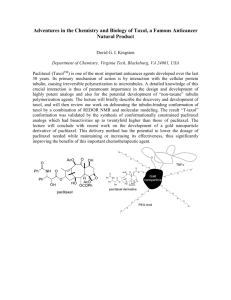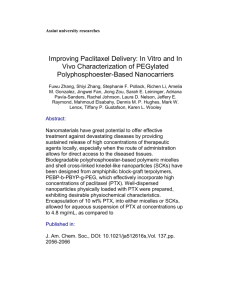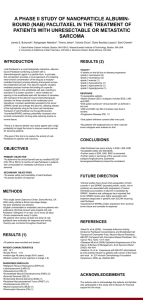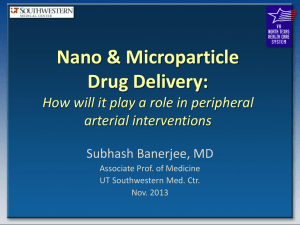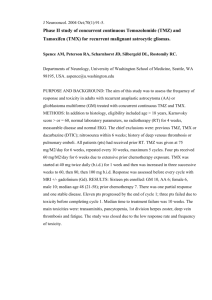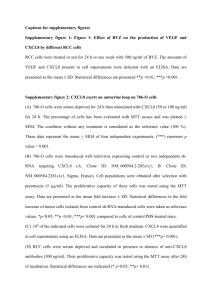Nanotechnology for Tumor- Targeted Drug and Gene
advertisement
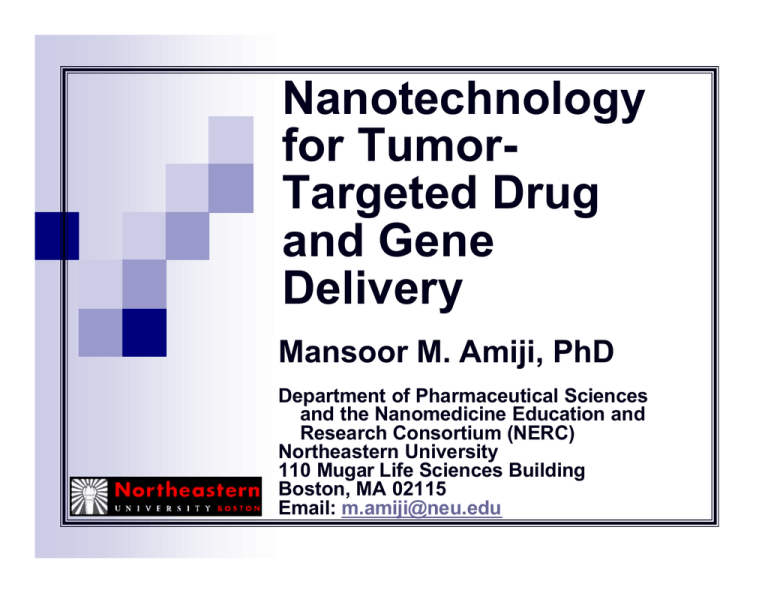
Nanotechnology for TumorTargeted Drug and Gene Delivery Mansoor M. Amiji, PhD Department of Pharmaceutical Sciences and the Nanomedicine Education and Research Consortium (NERC) Northeastern University 110 Mugar Life Sciences Building Boston, MA 02115 Email: m.amiji@neu.edu Early Disease Detection Targeted Therapy Nanotechnology Platforms Organic Nanostructures qPolymeric nanoparticles qLipid systems (liposomes, emulsions) qSelf-assemblies (micelles, etc) qDendrimers qCarbon nanostructures (nanotubes, fullerenes) Inorganic Nanostructures qMetal nanoparticles and nanoshells qSilicon nanostructures qNanocrystals (quantum dots) Tumor Microenvironment Tumor Mass Ref: R.K. Jain. Scientific American, 271: 58-65 (1994). Pore Size Cut-Off of Tumor Blood Vessels Representative electron micrographs of MCa IV tumor vessels grown in the dorsal chamber The vascular pore cutoff size for six different types of tumors grown in the dorsal chamber (A) and four tumors grown in the cranial window (B) was evaluated Ref. Hobbs, S.K. et al. Proc. Natl. Acad. Sci. USA 95, 4607-4612 (1998). Passive Delivery Strategies Physical approaches qSize (less than 400 nm in diameter). qSurface charge (positive particles have longer tumor residence time). Chemical approaches qpH responsiveness. qRedox. qSurface modification with PEG/PEO. Active Delivery Strategies Surface Attachment of Targeting Ligand qLow molecular weight ligands (folate, thiamine, sugars) qPeptides (RGD, LHRH) qProteins (transferrin, antibodies, lectins) qPolysaccharides (hyaluronic acid) Polymeric Nanoparticles q Polymers offer a versatile platform for designing nanocarrier systems (hydrophilic, hydrophobic, biodegradable, charged, etc). q Fabrication methods are simple, reproducible, and can be scaled-up according to cGMP (e.g., Abraxane®). q Nanoparticles offer large area-to-volume ratio for maximum payload capacity. q Surfaces can be modified for passive or active targeting. q Stability of the payload is improved upon encapsulation. q Release profile of the drug can be controlled based on polymer properties (sustained release, pH-sensitive release, etc). Polymeric Nanoparticles for TumorTargeted Delivery Weight % PEO-PCL Coulter Analysis Weight % PEO-PBAE Size (nm) Size (nm) SEM Image Time-Dependent Uptake and Distribution of Nanoparticles in Breast Cancer Cells PEO-PCL DIC Fluorescence 30 minutes 10 minutes Fluorescence 60 minutes 60 minutes 30 minutes 15 minutes DIC PEO-PBAE PEO-PCL nanoparticles, encapsulated with fluorescent dye and PEO-PBAE nanoparticles encapsulated with Oregon Green-paclitaxel were internalized by non-specific endocytosis, followed by vesicular transport in the cytosol. After 1 hour, majority of the nanoparticles were localized in the cytosol and in the vicinity of their target. Intracellular Paclitaxel Concentrations upon Administration in Nanoparticle Formulations Cellular PTX Concentrations Upon Continuous Exposure 0.9 0.8 0.7 0.6 0.5 Paclitaxel in Aqueous Solution 0.4 Paclitaxel in PEO-PBAE Nanocarriers 0.3 Paclitaxel in PEO-PCL Nanocarriers 0.2 Dose: 1 µM 0.1 0 0 2 Time (h) 4 6 Concentration of Paclitaxel in Cells (µM) Concentration of Paclitaxel in Cells (µM) Cellular PTX Concentration After Acute Exposure 0.45 Paclitaxel in Aqueous Solution 0.40 Paclitaxel in PEO-PBAE Nanocarriers Paclitaxel in PEO-PCL Nanocarriers 0.35 0.30 0.25 0.20 0.15 0.10 0.05 Dose: 1 µM 0.00 0 1 2 3 4 5 6 Time (h) Tritiated [3H] paclitaxel was administered as control aqueous solution or in PEO-PCL and PEOPBAE nanoparticle formulations in MDA-MB-231 breast cancer cells. For acute exposure, the formulation was washed away after 6 hour incubation and the drug concentrations in the cells were measured over time. For chronic exposure, the formulation was left in the culture environment and the cells were periodically analyzed for drug content. Cytotoxicity of Paclitaxel upon Administration in the Nanoparticle Formulations Cell-Kill Efficiency of PTX After Short Term Exposure Drug Exposure Time = 6 hours Cell-Kill Efficiency of PTX After Long-Term Exposure 120 Drug Exposure Time = 6 days 120 100 Percentage Cell Viability Percentage Cell Viability 110 100 90 80 Paclitaxel in Aqueous solution 70 Paclitaxel in PEO-PCL Nanocarriers Paclitaxel in PEO-PBAE Nanocarriers 80 60 40 Paclitaxel in Solution 60 Paclitaxel in PEO-PCL Nanocarriers Paclitaxel in PEO-PBAE Nanocarriers 50 0.001 0.01 0.1 Log [Paclitaxel Concentration (µM)] 20 1 10 0 0.001 0.01 0.1 1 10 Log [Paclitaxel Concentration (µM)] Paclitaxel was administered as control aqueous solution or in PEO-PCL and PEO-PBAE nanoparticle formulations in MDA-MB-231 breast cancer cells. For short-term exposure, the formulation was washed away after 6 hour incubation and the cell viability was determined. For continuous exposure, the formulation was left in the culture environment for up to 6 days and the cell viability was measured using MTS assay. Nanoparticle-Mediated In Vivo Drug Delivery in Human Cancer Xenograft Models Paclitaxel in SKOV-3 Xenograft Model Tamoxifen in MDA -MB -231 Xenograft Model SKOV-3 35 Paclitaxel Concentration in Tumor Mass (µg/g of tissue) 40 Plain Injection %Total activity recovered per whole tissue NP with no stabilizer 30 NP with F-68 NP with F-108 25 20 15 10 5 0 1 hr post-injection 6 hrs post-injection Paclitaxel in Solution Paclitaxel in PEO-PBAE Nanocarriers Paclitaxel in PEO-PCL Nanocarriers 5 4 3 2 1 0 1 hour 5 hours Time Tritiated [3H]-tamoxifen or pacliatxel was encapsulated in PEO-PCL and PEO-PBAE nanoparticles and intravenously administered to female Nu/Nu (athymic) mice bearing MDAMB-231 or SKOV-3 human cancer xenografts. Therapeutic Efficacy of Nanoparticle-Mediated Delivery in Human Cancer Xenograft Models Tumor Volumes Tumor Weights 200 Control PTX Solution PCL-PTX NP's PbAE-PTX NP's 0.8 0.7 Tumor Weight (g) Tumor Volume (mm3) 250 150 100 0.6 0.5 0.4 0.3 0.2 0.1 50 0 Control 0 5 10 15 20 25 PTX Solution PCL-PTX NP's PbAE-PTX NP's 30 Time after Tumor Inoculation (days) Paclitaxel was encapsulated in PEO-PCL and PEO-PBAE nanoparticles and administered intravenously to female Nu/Nu (athymic) mice bearing SKOV-3 human cancer xenografts. Intracellular Ceramide Modulation: Strategy to to Overcome Drug Resistance Synthesis Metabolism Enhancement of Intracellular Ceramide Production Inhibition of Intracellular Ceramide Metabolism Exogenous Ceramide Administration Multifunctional Nanoparticle Systems – “Pack Hunting Strategy” From Jurassic Park III: The Lost World Multifunctional Nanocarriers for Reversal of Drug Resistance in Cancer Paclitaxel and Tamoxifen Paclitaxel and C6 Ceramide [paclitaxel] [paclitaxel] 10 nM 120 10 nM 1 µM Percent Cell Viability Percent Cell Viability SKOV-3 p<0.001 120 100 80 60 40 20 100 80 60 40 20 0 0 control C6-ceramide 10 µM paclitaxel paclitaxel + C6ceramide control paclitaxel paclitaxel + tamoxifen 140 1 µM p<0.001 10 nM 10 nM p<0.001 100 80 60 40 20 0 Percent Cell Viability Percent Cell Viability SKOV-3TR p<0.001 120 tamoxifen 15 µM [paclitaxel] [paclitaxel] 140 p<0.001 1 µM p<0.001 1 µM 120 100 80 60 40 20 0 control C6-ceramide 10 µM paclitaxel paclitaxel + C6ceramide control tamoxifen 15 µM paclitaxel paclitaxel + tamoxifen Paclitaxel, C6 ceramide, and tamoxifen were encapsulated in PEO-PCL nanoparticles and administered to sensitive and resistant SKOV-3 ovarian carcinoma cells. National Cancer Institute Announces $35 Million in Awards to 12 Cancer Nanotechnology Platform Partnerships FOR IMMEDIATE RELEASE Monday, October 17, 2005 National Cancer Institute Announces $35 Million in Awards to 12 Cancer Nanotechnology Platform Partnerships The National Cancer Institute (NCI), part of the National Institutes of Health (NIH), today announced funding for a major component of its $144.3 million, fiveyear initiative for nanotechnology in cancer research. Awards totaling $35 million over five years, with $7 million total in the first year, will establish 12 Cancer Nanotechnology Platform Partnerships. [ Click here to read the full press release ] Cellular Uptake and Trafficking of DNA Delivered in Non-Viral Vectors (A) DNA Complex Formation, (B) Uptake, (C) Endocytosis (endosome), (D) Escape from Endosome, (E) Degradation (endosome), (F) Intracellular Release, (G) Degradation (cytosol), (H) Nuclear Targeting, (I) Nuclear Entry and Expression. Ref: D. Luo and W.M. Saltzman. Nature Biotech., 18(1):33-37 (2000). Nanoparticles for Targeted Gene Delivery SEM Images Control Gelatin Coulter Analysis PEGylated Gelatin 1.0 µm 1.0 µm In Vitro Transfection of GFP-Expressing Plasmid DNA EGFP-N1 plasmid DNA was administered in control and PEG-modified gelatin nanoparticles to NIH-3T3 murine fibroblast cells. Periodically, transgene expression was measured qualitatively with confocal microscopy and quantitatively with fluorescence-activated cell sorter. In Vivo Transfection in Solid Tumor Model Tumor expression of beta-galactosidase after nanoparticle-mediated intravenous and intratumoral administration of pCMV-beta in Lewis lung carcinoma-bearing female C57BL/6J mice. Quantitative results were obtained by enzymatic conversion of o-nitrophenol (ONP) from o-nitrophenol galactoside (ONPG) by measuring the absorbance at 420 nm. In Vitro Transfection of sFlt-1 Plasmid DNA in MDA-MB-435 Breast Cancer Cells Qualitative Expression (Western Blot) Quantitative Expression (ELISA) 1 700 2 3 4 5 6 7 8 Gel sFLt-1 Concentration (pg/ml) 600 SHGel PEG-Gel PEG-SHGel 500 Lipo Naked Plasmid 400 300 200 100 0 0 1 2 3 4 5 6 7 8 9 Human sFlt-1 expression in the supernatant of cultured MDAMB-435 cells following 48 hours post-transfection with plasmid DNA. Lane 1 : Gel Nps encapsulated with pCDNA3-sFlt-1 Lane 2 : SH-Gel Nps encapsulated with pCDNA3-sFlt-1 Lane 3 : PEG-Gel Nps encapsulated with pCDNA3-sFlt-1 Lane 4 : PEG-SHGel Nps encapsulated with pCDNA3-sFlt-1 Lane 5 : Lipofectin complexed with pCDNA3-sFlt-1 Lane 6: Naked pCDNA3-sFlt-1 Lane 7: Untreated Cells Lane 8: Recombinant protein sFlt-1 Time (days) Soluble Flt-1 (sFlt-1) encoding plasmid DNA in control and nanocarrier formulations was administered to MDA-MB-435 breast adenocarcinoma cells. The expression of sFlt-1 was measured in the culture media using an ELISA and Western blot assays. In Vivo Transfection and Therapeutic Efficacy of sFlt-1 Plasmid DNA in Breast Tumor Model CD-31 Stained Tumor Volume Changes Untreated PEG-Gel Nps PEG-SHGel Nps 120 Naked Plasmid DNA 100 80 60 40 20 0 0 5 10 15 20 25 30 PEG-S H-Gel Np Tumor Volume (mm3) 140 Untreated Control 160 Time (days) In vivo transfection and efficacy of sFlt-1 following intravenous administration of the control and PEG-modified gelatin-based nanocarriers in MDA-MB-435 human breast cancer bearing mice. The tumor volume changes were measured daily post-administration of 60 µg total plasmid DNA dose. The microvessel density in tumor cryosections was evaluated (shown with arrows) by CD-31 antibody staining Engineered Multifunctional Nanoemulsions Flaxseed Oil NE Nanoemulsion Safflower Oil NE Particle Size (nm) Zeta Potential (mV) Standard 91 ± 17 - 15.7 ± 8.9 Stearylamine 99 ± 10 16.0 ± 4.4 Deoxycholic Acid 134 ± 10 - 11.1 ± 6.0 Oral Bioavailability Enhancement of Paclitaxel in Nanoemulsion Formulations Percent Activity/gram of Tissue 6 Control solution NE-Stearylamine NE-Deoxycholic acid NE-Standard 4 AUC (%h/g) Formulation Control Solution Standard NE Stearylamine NE Deoxycholic acid NE 6.8 ± 0.99 15.9 ± 3.14 20.6 ± 3.01 33.5 ± 5.9 2 0 0 10 20 30 40 50 60 Time (hour) 3H-paclitaxel encapsulation in nanoemulsions was dosed orally to C57BL/6J mice. Plasma and tissue concentrations were measured from radioactivity values. Delivery of Paclitaxel Across the Blood-Brain Barrier in Nanoemulsion Formulations Paclitaxel Conc.( µ g/gram) 4.5 4.0 1 hr 3.5 6 hr 3.0 2.5 2.0 1.5 1.0 0.5 0.0 Control Solution Tween 80-NE SA-NE Nanoemulsion Formulations 3H-Paclitaxel encapsulation in nanoemulsions was dosed intravenously in Balb/c mice. Plasma and brain concentrations were measured periodically. Gd-Nanoemulsions for Image-Guided Cancer Therapy Mouse Brain MRI Scan T1 Relaxation Time Measurements 120 R1 = 9.2 mM -1sec-1 1/T1 (1/sec) 100 80 60 40 20 0 0 2 4 6 8 10 12 14 Gd Concentration (mM) Gd-stearylamine nanoemulsions were prepared by complexing Gd with DTPA-PE and then incorporating in the nanoemulsion systems at different molar concentrations. In the in vivo studies, the formulation was administered intravenously to naïve mice. 120 Aq.solution Nanoemulsion 100 ViableCells(%) PTX Alone Rhodamine-PTX Paclitaxel and Ceramide Combination in Brain Tumor Therapy: In Vitro Studies 80 60 40 20 0 1 nM 10 nM 100 nM 120 Aq.solution ViableCells(%) CER Alone NBD-C6 Ceramide Concentration of PTX 100 Nanoemulsion 80 60 40 20 0 1 uM 10 uM Concentration of CER ViableCells(%) PTX + CER Merged 120 Aq.solution Nanoemulsion 100 80 60 40 20 0 1 nM + 1 uM 10 nM + 10 uM 100 nM + 10 uM Concentration of PTX + CER Metal Nanoparticles Gold-Silver Alloy NP (Mole% Ag) 0 10 25 50 100 Gold-Gadolinium Alloy NP (Mole% Gd) 0 10 25 50 75 Plasmon Band at 525 nm Near IR Peak at 800 nm 50 nm Gold Nanoparticles Gold Nanorods Functionalization of Gold Nanoparticle Surfaces Using Hetero-bifunctional PEG O 'desymmetrization' Ag2O, KI OH-PEG-OH CH2Cl2, 0oC, 30 min n = 1.5 K HO-PEG-OTs K+ - S O Me, MeOH, reflux, 48 hr HO-PEG-S Me (90%) (95%) Coumarin-isocyanate (85%) toluene, reflux Me O O O N H O-PEG- S Au Coumarin-Functionalized Gold Nanoparticles Me Au + Gold Nanoparticles TEM Me NaOMe / MeOH then, Dowex DR 2030 O O O N H O-PEG-SH Coumarin-PEG Thiol Fluorescemce Nucleus (76%) O O O O N H O-PEG-S Me Superparamagnetic Iron Oxide-Gold Core Shell Nanoparticles 50-80 nm Targeting Ligand PEG Spacer Iron Oxide Core Gold Shell Nanoparticle-Tagged RBC (before magnetic field) Nanoparticle-Tagged RBC (after magnetic field) < Approx. 60 nm iron oxide/gold core-shell nanoparticles with about 5 nm gold shell. < Surface modification, using hetero-bifunctional PEG, for attachment of bioactive (targeting) ligands. < Cell separation using magnetic field. < Magnetic nano-sensors and nano-harvestors. < Targeted MRI contrast agent (T 2 = 30 msec). < Magnetic hyperthermia. “….AT 9 O'CLOCK on the night of my first round of chemotherapy, exactly six hours after I left the oncologist's office wondering what all the fuss was about, my stomach tumbled into my knees, my knees refused to work altogether, and I crumpled to the floor in a clammy, shivering heap. I lay there until dawn, at one point vomiting on myself, at another crying that I'd rather die of cancer than undergo chemo again. I was hot. I was cold. My shoulders wouldn't stop shaking. My legs wouldn't move at all. Huge hallucinations rolled over me….” Lynda Gorov May 2, 2006 Acknowledgements u Financial Support - National Institutes of Health (RO1’s and SBIR) - National Science Foundation (IGERT) - Foundations ( PhRMA, AACP, etc) - Private Industries (Boston Scientific, Novavax, etc) - Intramural Support (RSDF and URF) u Research Collaborators - Robert Langer, Vladimir Torchilin, and Michael Seiden. - Nanomedicine Education and Research Consortium (NERC) at Northeastern University. u Trainees - Post-Doctoral Associates - PhD and MS Students - Pharmacy Honors Students
